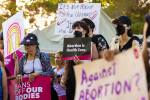Report paints bleak cancer survival rate for Nevadans
If you get breast cancer in Las Vegas, you're more likely to die than if you get breast cancer in Reno.
That is one among many dire findings in a joint report released this week by researchers at UNLV and the Nevada State Health Division.
"Southern Nevada is worse, but Northern Nevada is nothing to write home about either," said Dr. Paulo Pinheiro, a UNLV professor of epidemiology and the report's lead author.
Women who are diagnosed with breast cancer have an 82 percent survival rate in Northern Nevada after four years. It is 73 percent in Southern Nevada.
The 95-page report also finds:
■ Nevadans are more likely to get, and die of, cancer than residents of neighboring states.
■ Nevada women, especially white women, show among the highest death rates for lung, colorectal and liver cancers in the country.
■ Whites in Nevada have higher cancer rates than all other racial groups for breast, bladder and colorectal cancers.
■ Nine percent of Nevadans seek diagnosis and treatment out of state.
■ During the years studied, 2006-2008, Southern Nevadans had a higher incidence of cancer, more cancer deaths and lower screening rates than Northern Nevada residents.
■ Between 2006 and 2008, 457 of every 100,000 Nevadans were diagnosed with cancer. That is higher than California, with 442; Utah, with 397; and Arizona, with 395.
■ The most common cancer diagnosis in all four states was prostate cancer, followed by breast cancer.
■ The deadliest cancer in Nevada was lung cancer, with 1,309 deaths.
"Compared to the U.S., mortality rates in Nevada are average for men, but 4 percent higher for women," the report said.
Pinheiro said cancer rates in general have long been higher in Nevada than neighboring states.
"That's to be expected," he said. "The prevalence of smoking is higher among Nevadans than in neighboring states."
He said it remains unclear why people diagnosed with cancer are more likely to die in Southern Nevada than Northern Nevada, though.
More study is needed.
Pinheiro speculated that there are probably several factors, including the quality of treatment and the availability of prevention and screening programs.
"We are the only city of 2 million people without a school of medicine and a teaching hospital based here," he said.
The University of Nevada School of Medicine is based in Reno. Some of the training takes place at University Medical Center in Las Vegas, and some medical faculty live here.
Pinheiro said medical schools attract experts and grant money for research projects that often have a direct effect on the community.
Often, when cancer is diagnosed, it is diagnosed late, sometimes too late for effective treatment.
He said more funding for early screening programs, particularly among the poor and uninsured, could go a long way toward catching cancer early enough for treatment to be effective.
Tom McCoy, the Nevada government relations director for the state branch of the American Cancer Society, said the state has a high number of uninsured.
"You're talking about a half million people without insurance," said McCoy, who was not part of the UNLV study.
According to the Kaiser Family Foundation, 22 percent of Nevadans have no health insurance, compared to 16 percent nationally.
The UNLV report recommends several steps that could improve diagnosis and outcomes. Among them are the following:
■ Increase screening rates for colorectal, breast and cervical cancers.
■ Study the connection between firsthand, secondhand and third-hand smoke in lung cancer, especially in women.
■ Consider raising the tax on cigarettes and strengthen the ban on smoking in public places.
■ Further study the reasons behind the higher cancer rates and lower survival rates in Southern Nevada versus Northern Nevada.
Contact reporter Richard Lake at rlake@reviewjournal.com or 702-383-0307.























